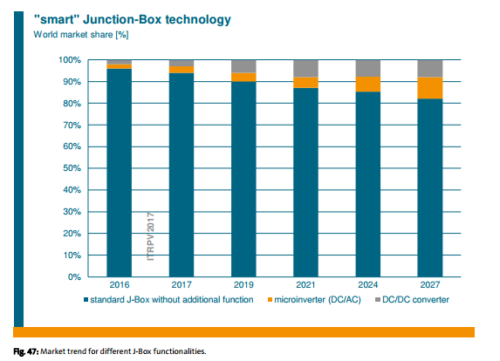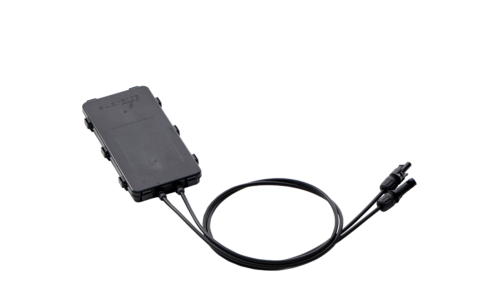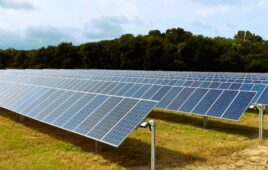The junction box is often an overlooked piece of the solar panel. Usually pre-installed on the backside of a solar module, installers pay it little mind until connecting panels.
The PV junction box has a simple, but important role: housing all the electric bits on a solar panel and protecting them from the environment. Wires connect to diodes inside, providing an easy way to link panels together.
Although solar developers and owners don’t get a choice in junction box type—module companies work out those contracts during manufacturing—the role of this enclosure is still important to understand, especially as it houses more “smart” technologies.
Junction box basics
A junction box has bypass diodes that keep power flowing in one direction and prevent it from feeding back to the panels. Frank Rosenkranz, product manager of solar for EMEA, India and Americas for connector and junction box manufacturer TE Connectivity, described the junction box as the “most important part on a panel.”

A TE Connectivity junction box
“Every string is protected by a diode [in the junction box],” he said. “The diode is the gateway that allows an endless stream of power.”
If part of a solar panel is shaded, that string will want to consume power, reversing the flow of electricity. Diodes inside the junction box prevent that from happening.
There are two different junction box production techniques—soldering/potting and clamping. With the soldering and potting method, foils coming out of the solar panel are soldered to the diodes in the junction box. The junction box then has to be potted or filled with a type of sticky material to allow thermal transfer of heat, keep the solder joint in place and prevent it from failing. Once enough time has passed for sufficient curing of the potting material, the panel is good to go.
With clamping production, a simple clamping mechanism attaches the foil to the wires. There are no fumes or major cleanup as with the soldering/potting method. The prices of both methods are fairly equal when comparing material and labor costs as a whole. The clamping box may be more expensive, but the labor needed to solder and pot the other boxes is often higher.
Although there are differing opinions on the best way to produce a junction box, there has been little discussion over the main role of this often-ignored product—until new technologies got involved in the industry.
Junction box evolution
As modules have changed, the junction box has kept the same functionality. But now with increased power outputs and voltages, junction boxes have had to improve their ability to protect that power.
“The general role of the junction box has remained the same. What’s changed is the modules keep getting more powerful,” said Brian Mills, North American PV product manager with Stäubli Electrical Connectors. “As the module output gets higher, those bypass diodes have to do more work. The way they absorb that energy is by shedding heat. You have to handle that heat of the diodes.”
Cool bypass switches are replacing traditional diodes in some junction boxes to mitigate the excessive heat generated by higher module outputs. When shaded panels want to instinctively consume power, a traditional diode prevents that from happening, but heat is generated in the process. A cool bypass switch works like an on/off switch and opens the circuit when panels are trying to pull energy, preventing heat from building up.

Survey participants for the International Technology Roadmap for Photovoltaic Results 2016 believe standard junction boxes without any additional function except bypass diodes will dominate the market over the next 10 years, although smarter technologies will begin to gain ground.
“Bypassing diodes are 1950s technology. It’s very simple,” Mills said. “They’re robust and reliable, but that heat generation thing has always been an issue.” Cool bypass switches solve that heat issue, but they’re much more expensive than a 20-cent diode. And everyone wants modules to be as cheap as possible.
To get the most bang for their buck, many system owners are turning to bifacial panels. Energy is still fed through one junction box even though power is being produced on both the front and backside of the module. Junction box manufacturers have had to get creative with their designs.
“On a bifacial panel, you have to position the junction boxes on the edge where you are definitely sure the backside is not shaded,” Rosenkranz said. “When on the edge, the junction box is no longer possible to be a rectangle, it has to be small.”
TE Connectivity offers three small SOLARLOK PV Edge junction boxes for bifacial modules, one each for the left corner, middle and right corner of the module, effectively working the same as one larger rectangular box. Stäubli is developing a junction box for positioning along the absolute edge of bifacial modules.
Bifacial modules’ quick gain in popularity meant that junction box designs had to be upgraded on the fly. Other sudden updates to solar systems include rapid shutdown and various module-level functionality requested by the National Electrical Code, and the junction box has to keep up.
“The industry is changing so quickly, it’s hard to stick with one enclosure and hope it’s viable,” Mills said. “How do you make a device that can handle PV temperatures and operate properly and last long term? How do you make it so you can switch out that technology if it goes bad or becomes obsolete? The junction box now has to be able opened up and closed.”
Stäubli’s PV-JB/MF multifunction junction box is customizable with an open-format, so it’s ready for any future updates, including entire optimizers or microinverters if their electronics get small enough.

The SolarEdge embedded optimizer with junction box capabilities
TE Connectivity has also recently launched a smart junction box that enables customized printed circuit boards (PCBs) to be integrated into solar panel solutions with monitoring, optimizing and rapid shutdown functionality.
Most microinverters and optimizers are added to the back of the module in addition to the junction box. But SolarEdge’s power optimizer can replace the junction box on factory-assembled smart modules. The embedded power optimizer provides smart capabilities while performing the basic power functions of a junction box.
“It has an advanced thermal design to enable heat dissipation to maintain lower cell temperature and avoid hot spots,” said Lior Handelsman, SolarEdge founder and vice president of marketing and product strategy. “We have specifically designed our embedded power optimizer to allow for manufacturing flexibility so that module manufacturers can quickly adjust manufacturing according to demand. We [designed] a fixed base with bypass diodes and then two separate covers. One cover holds a power optimizer, while the other is for a standard junction box with a bypass connector.”
Junction box manufacturers are also looking into adding inverter technology to their future models.
“The next step is going to be that module that has the inverter in the standard junction box with one AC source coming out,” Mills said. “It simplifies the installation and makes the module more versatile.”
Looks like the overlooked junction box is attracting more attention.
Learn more about the junction box in our Solar Basics video.




There really should be a standard format junction box for single face panels that allow for future upgrade, repair and trouble shooting, but cost of this might be the limiting factor.
I like the idea of the Stäubli junction box.
I am looking at making a sub-panel optimizer board based on the Maxim Max20801 chip.
The idea is to have 1 optimizer for each of the 3 strings in a panel and works using MPPT tracking under the control of the master MPPT tracking of the main inverter/microinverter.
The Maxim Integrated junction box is built into the Jinko Cheetah 320W panels, but now seems to have fallen out of favour.
As suggested in the article, if there was a standard junction box, then you could swap out the 3 diodes for either a Maxim module, Tigo full panel optimizer/shutdown/monitoring or microinverter.
Should the Junction box necessarily be on the Panel itself? If it were a separate unit with wires connecting to the 4 points on the panel, it would simplify replacement / maintenance. This would also easy enable upgradability in future. Another benefit of doing this would be that super thin profile can be easily achieved with the junction box being placed (closely) off the panel.
Great stuff,
Would a junction box rated 230w and up work on a 200watt designed panel?
I just found one of my collectors not getting power to my micro inverter. tested my inverter with another collector and it worked fine, so it must be in my junction box . I popped off the cover, cannot see any thing . from what i have looked on line ,it is sounds like the diodes. can these be tested while in box. also can these be changed with out removing the whole box. I would appreciate any suggestions.
Hi all, recently we have faced Junction box terminal fuse burnt issue in the field. Can you please tell the possible causes for this problem?Thanks
Hi Selva,
If I understand correctly you mean the MC4 connection of the optimizer. This is one of the common failures due to overheating.
Hope this helps.
OS
the tabs coming out of my solar panel are not long enough to work on my new junction box. what can i do to make them longer and where can i get it.
Hi James,
You can use wires and it needs to be with the correct current rating. You can check the current rating from the datasheet of the JB. Make sure you thermally protect the wires as they can get heated during operation.
I’d highly recommend checking with your installers before you take any actions. Please get professional help if your electric soldering skills are not good.
Best,
OS
I’m trying to find a website that addresses the issue I’m concerned about. What would cause a solar panel to not generate any electricity? How do you open the junction box?
Hi Kelly,
This is a vague question because the problem could be anywhere: junction box (JB), panel, or the gateway. Most of the advanced optimizers/JB are installed with a secondary diode which on JB failure are activated and then that particular panel will stop generating power and act as a diode (meaning no generation). In addition, if you are panel is installed with basic diode JB and still, your panel is not generating power, your solar cells might be broken.
Opening a JB is quite simple as it is designed so the installers can take very little time on replacing/inspecting it. Depending on your JB, it may just take a simple screwdriver to open it.
Hope this helps, if you already have found a solution to your panel not working I would be very interested to hear about it. Always consult your installers before taking any action on your solar panel and JB.
OS
We are trying to find a source to replace some of the junction boxes on our panels that were burnt during an electrical storm we bought 240 watt panels from Ames and are having a problem finding replacement junction boxes so we don’t have to junk the panels
Hi Ron,
It depends on how the optimizers are mounted. Some are clamped to the panel frame and can be easily removed and some are glued with the panel. If they are glued with the panel, you need to be very careful in removing those optimizers as any small damage on the panel can destroy the cells and you will have to change your panel completely. It is better to ask your installer to look into the problem.
Secondly, if you still go forward on doing it on your own and if you are successful, you may find some add-on optimizers e.g. SolarEdge optimizers, etc. which you can install.
Hope this helps!
OS